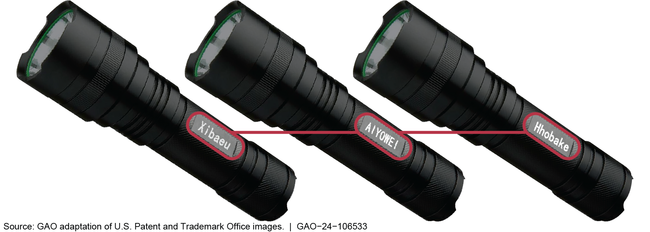Intellectual Property: Stronger Fraud Risk Management Could Improve the Integrity of the Trademark System
Fast Facts
A trademark is a word, phrase, or symbol that identifies a product or service.
Trademarks registered with the U.S. Patent and Trademark Office must be tied to goods or services that are being sold. In recent years, an influx of applications included many trademarks that aren't in use. Registrations for such trademarks may include false or inaccurate claims and could be fraudulent.
In 2022, USPTO started allowing challenges to registrations, which led USPTO to remove thousands of trademarks that aren't in use from the register. There could be up to 1 million more.
We recommended improving USPTO's fraud risk management to help address the problem.
U.S. Patent and Trademark Office headquarters in Alexandria, VA

Highlights
What GAO Found
The Trademark Modernization Act of 2020 (TMA) established two new procedures—expungement and reexamination—that allow individuals and businesses to challenge a registered trademark on the basis that it was not used in commerce, as is normally required. A successful challenge results in the trademark being removed from the register, thus making it available for potential use for the challenger or other applicants.
GAO found that from December 2021 through June 2023 the U.S. Patent and Trademark Office (USPTO) and attorneys representing trademark owners filed nearly 500 petitions under the new procedures. Collectively, these petitions resulted in the removal of more than 2,500 falsely claimed goods and services from the trademark register. Trademark attorneys told GAO that the new procedures can be cost-effective and low-risk.
Existing USPTO programs have also addressed inaccurate or false trademark applications and registrations. The agency's post registration audit program removed trademarked goods and services in about half of its randomly selected audits each year from the start of the program in 2017. This suggests that there may be more than 1 million false and inaccurate registrations out of about 2.8 million overall due to an influx of applications, among other factors.
Fraudulent Images of the Same Flashlight with Different Logos Included in Trademark Applications Submitted to USPTO

The USPTO has taken steps to limit fraud risks, such as establishing a culture conducive to fraud risk management. However, the USPTO has not conducted a comprehensive fraud risk assessment of the trademark register or designed a fraud risk strategy. Implementing leading practices from GAO's Fraud Risk Framework would allow the USPTO to comprehensively consider fraud risks, establish more effective controls, and fully articulate a tolerable level of fraud risk while considering the costs and benefits of potential control activities. GAO also found that the USPTO's current data systems do not allow the agency to: (1) assess the effectiveness of current trademark fraud prevention programs and (2) implement new technologies for identifying fraud. Academics told GAO that computational tools such as predictive analytics could help the USPTO identify trademark applications with false or inaccurate information more effectively.
Why GAO Did This Study
Registering a trademark such as a word or symbol is often an essential part of building a business. In recent years there have been a growing number of trademark applications that include false or inaccurate images showing goods that are not actually sold or used in commerce. This has made it more difficult for businesses to find unused trademarks.
The TMA includes a provision for GAO to review the USPTO's efforts to address inaccurate and false claims in trademark applications and registrations. This report examines (1) the extent to which the USPTO and third parties used the new TMA procedures; (2) other USPTO initiatives; and (3) the extent to which USPTO used fraud risk principles to address the issue.
GAO analyzed USPTO trademark data related to TMA's new procedures and interviewed USPTO officials on other programs and procedures used to protect the integrity of the trademark register. GAO also evaluated the USPTO's current fraud risk practices against key elements of GAO's Fraud Risk Framework and conducted semi-structured interviews with trademark attorneys, top trademark-owning companies, academics, and trademark industry associations to obtain their views on the new procedures.
Recommendations
GAO is recommending that USPTO 1) conduct regular fraud risk assessments of the trademark register, and 2) improve its data systems to enable trademark data analytics for stronger fraud risk management. USPTO concurred with the recommendations.
Recommendations for Executive Action
| Agency Affected | Recommendation | Status |
|---|---|---|
| Patent and Trademark Office | Recommendation 1: The Commissioner for Trademarks should plan and conduct regular fraud risk assessments of the trademark register to determine a fraud risk profile that aligns with leading practices in the Fraud Risk Framework. Specifically, this process should include (1) identifying inherent fraud risks to the trademark register, (2) assessing the likelihood and impact of inherent fraud risks, (3) determining fraud risk tolerance, (4) examining the suitability of existing fraud controls, and (5) documenting the fraud risk profile. |
When we confirm what actions the agency has taken in response to this recommendation, we will provide updated information.
|
| Patent and Trademark Office | Recommendation 2: The Commissioner for Trademarks should identify and implement improvements to current data systems to strengthen trademark data analytics for stronger fraud risk management. |
When we confirm what actions the agency has taken in response to this recommendation, we will provide updated information.
|
